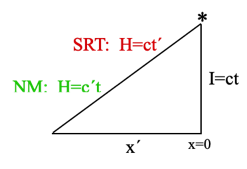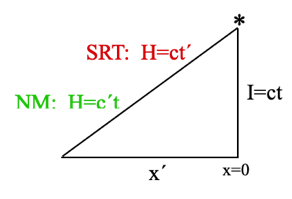Site map of:
E = γmc2
I2 = (ct)2 – x2 = (ct´)2 – x´2 =…

NM: Vwrt x=0 = (x´/t) = (x´/I)c
SRT: vwrt x=0=(x´/t´)=(x´/H)c
NM: Vwrt* = (H/t) = (c´t)/t = c´
SRT: vwrt * = (H/t´) = (ct´/t´) = c
x is the distance an object has traveled during the time t . I is the distance light has traveled, beginning at the same initial location, at speed c also for time t . The squares of x and I can be added to give the equation H2=I2+x2 , where H2 turns out to be the distance (Interval) between the object and the perpendicularly moving part of the light front now after the time t , as shown in the diagram.
Light starts up and object starts left from x=0 at time t=0;
after time t light is at top and object at left.
I2 = H2 – x2 = H12 – x12 = H22 – x22 = …
can be thought of as the Generalized Interval equation.
Since H>I and (I/t)=c , then (H/t)>(I/t) and (H/t)>c , call it (H/t)=c´ , i.e., H=c´t . Therefore, the above equation could be written
I2 = (c´t)2 – x2 = (c1´t)2 – x12 = (c2´t)2 – x22 = …
which, as shown in the diagram, is the Newtonian Mechanics (NM) version, i.e., the NM Interval equation. However, by Einstein’s Second Postulate (discussed below), there could be no c´ , only c . So Einstein simply changed H=c´t to the incorrect H=ct´ . So now, even though H>I , t is increased to t´ by the factor H/I [equals the gamma (γ) function as can be easily proven numerically] so as to make (H/(H/I)t) = (H/t´) = c = (I/t) . This leads to the Relativistic Interval equation
I2 = (ct´)2 – x2 = (ct1´)2 – x12 = (ct2´)2 – x22 = …
All the equations and concepts of Special Relativity (SRT) result from this one particular error. This isn’t how Einstein arrived at his conclusions but this is what resulted.
Why was this error made? Because Einstein used his completely flawed Second Postulate as a reason to change H=c´t to H=ct´ . What’s wrong with the Second Postulate? Paraphrasing from his 1905 paper, “light always travels at speed c in free space” [a vacuum]. This is a meaningless statement because you must always know: speed c (or any other speed) relative to what? “Everything” is not a suitable answer, as shown next.
A second way the Second Postulate is often expressed is that “light travels at speed c in all reference frames.” This is as obviously erroneous as saying that Leo (light) is moving away from George, Thomas, Paul, and Roger at the same speed as he is from James when the latter five are all moving in different directions and speeds with respect to each other. So much for the deeply flawed Second Postulate.
None of the experimental ‘proofs’ claimed to validate SRT are exclusive to SRT; they also fit NM ideas. Isn’t it time, after almost 120 years of error, to switch and convert from SRT to correct and understandable NM?
In summary, SRT is erroneous because it converted the NM expression c´t from the correct NM Interval equation to the erroneous ct´ expression of the Relativistic Interval equation based on the preposterous Second Postulate. Although this results in an erroneous velocity, v , for objects in SRT (vs. the correct velocity, V , for NM) and the non-existent ‘dilated time’ of SRT, no information is lost because the SRT version of events can always be converted to the correct and understandable description of NM. Since information is not lost in SRT, SRT sort of ‘works’; but it is terribly distorted and should be discarded. SRT depictions of events should be converted to NM.
Exactly Where Special Relativity
(SRT) is Wrong and Why
Dr. Sherwood Kaip
El Paso, TX
<skaip799@gmail.com>; cell: 1 (915) 309-6340
This material may be reproduced if author attribution is given.
To return from PRINT page, click "back" arrow on your browser
